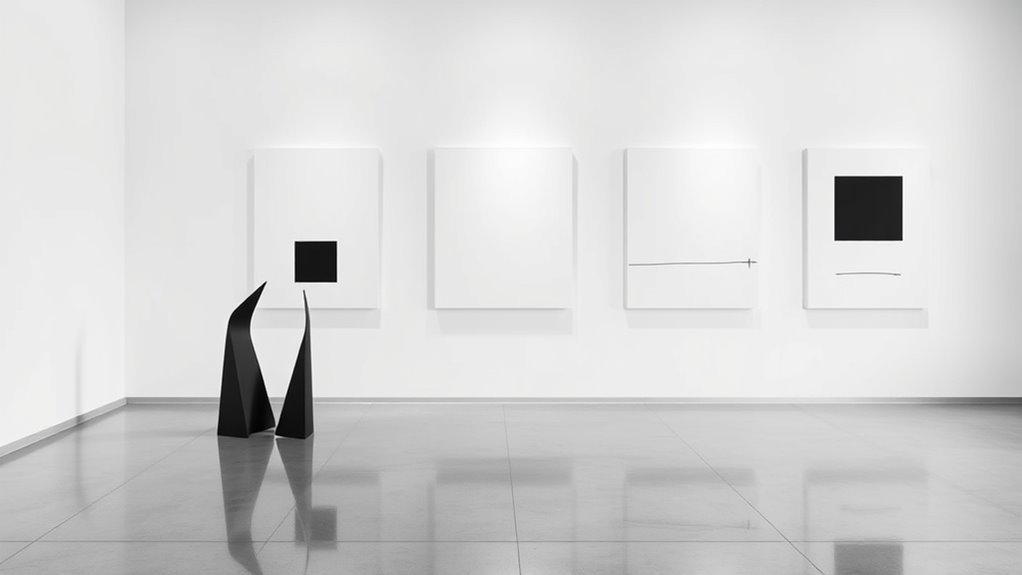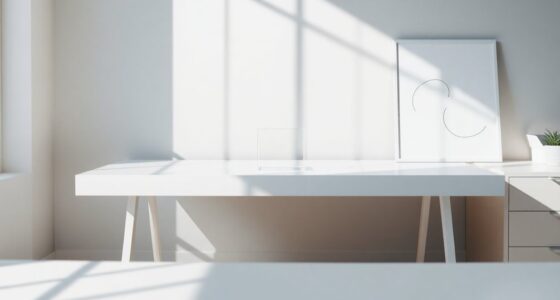Famous minimalist artists include Donald Judd, known for incorporating space and industrial materials into large geometric sculptures, and Dan Flavin, who used fluorescent light to transform environments. Agnes Martin’s subtle grid works evoke calm and meditation, while Sol LeWitt emphasizes ideas and instructions with wall drawings and systems. Frank Stella explores the power of bold geometric shapes and vibrant colors. Exploring these artists further reveals how their unique approaches shaped minimalist art’s enduring influence.
Key Takeaways
- Donald Judd is known for geometric sculptures that integrate architecture and occupy entire spaces.
- Dan Flavin revolutionized minimalism by using fluorescent light to create immersive luminous environments.
- Agnes Martin’s works feature delicate grids and subtle colors conveying serenity and meditative qualities.
- Sol LeWitt emphasizes conceptual art with large-scale wall drawings guided by precise instructions.
- Frank Stella’s art highlights bold geometric shapes and contrasting colors to evoke movement and depth.
Donald Judd: Pioneering Space and Form
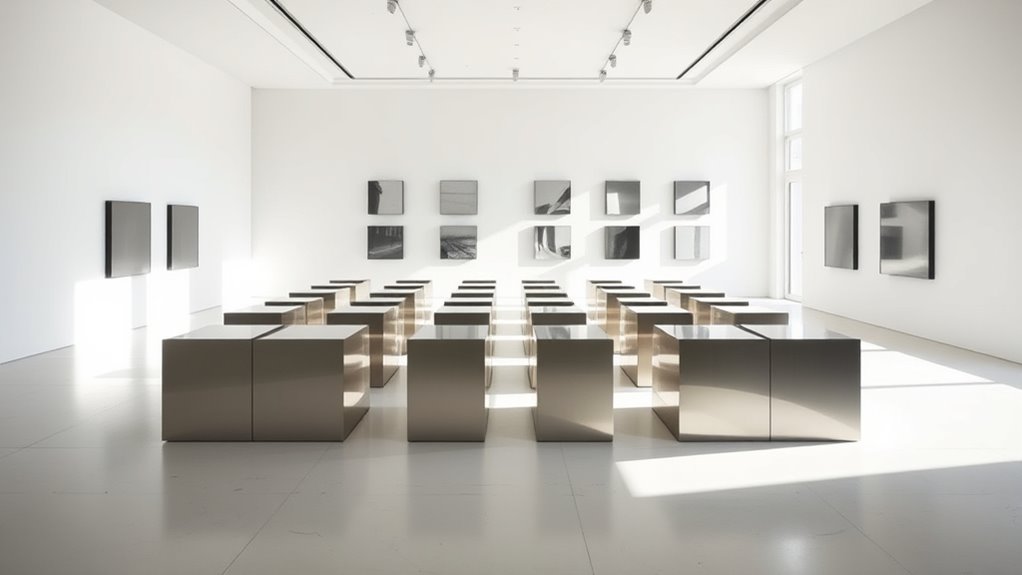
Donald Judd revolutionized minimalist art by focusing on the relationship between space and form. You notice his work emphasizes architectural integration, where art becomes part of the environment rather than separate from it.
Judd experiments with materials, choosing industrial-grade metals, plastics, and wood to create precise, geometric pieces. These materials aren’t just chosen for their appearance but for their structural qualities, allowing him to explore how form interacts with surrounding space.
His sculptures often occupy entire rooms, blurring the line between object and environment. By emphasizing clean lines and simple shapes, Judd encourages you to experience the artwork as an extension of the space itself. His approach transforms the way you perceive form, space, and material in minimalist art. Additionally, Judd’s focus on material properties highlights how the structural qualities of materials influence the aesthetic and conceptual aspects of his work. Recognizing the structural qualities of materials can deepen your appreciation of how form and function interplay in minimalist sculpture, especially as innovations in material technology continue to expand artistic possibilities.
Dan Flavin: Illuminating Minimalism With Light
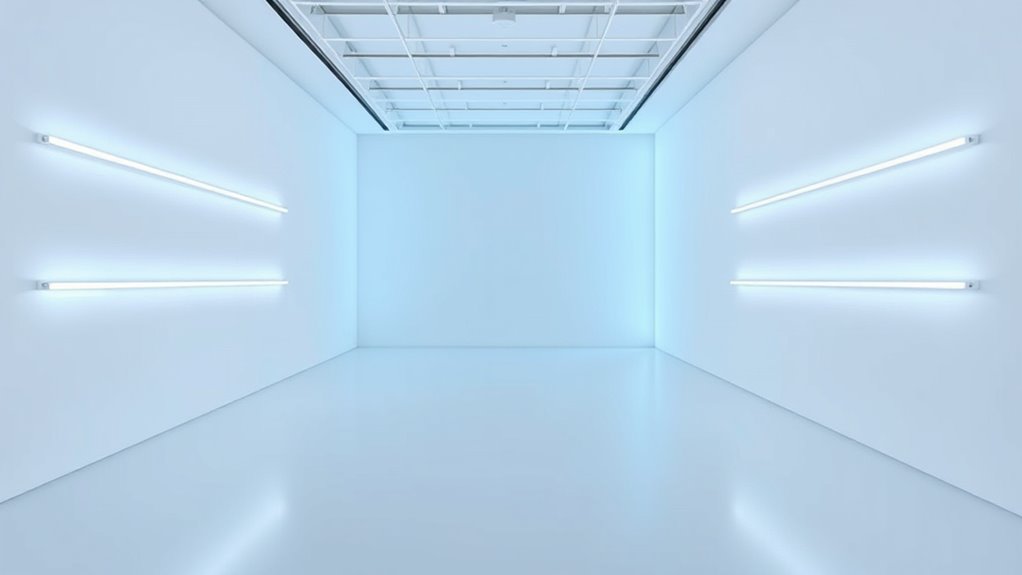
Although minimalism is often associated with simple shapes and materials, Dan Flavin revolutionized the movement by using light as his primary medium. His light installations transform space, inviting you to experience a new level of perception. As you step into his works, you notice a subtle glow that bathes the surroundings in a calming, ambient ambiance. His use of fluorescent tubes creates a luminous environment that plays with perception and space. Imagine standing in a room filled with: – Vertical and horizontal lines of glowing light – Soft, seamless progressions between colors – A sense of infinite depth and openness. These elements combine to produce an immersive environment. Flavin’s work emphasizes the essential role of light in shaping minimalist art and transforming everyday spaces into contemplative environments. Additionally, his innovative approach aligns with the market growth projected at over 40% CAGR in AI tech by 2025, highlighting how technological advancements continue to influence contemporary art practices.
Agnes Martin: Subtle Elegance in Line and Grid
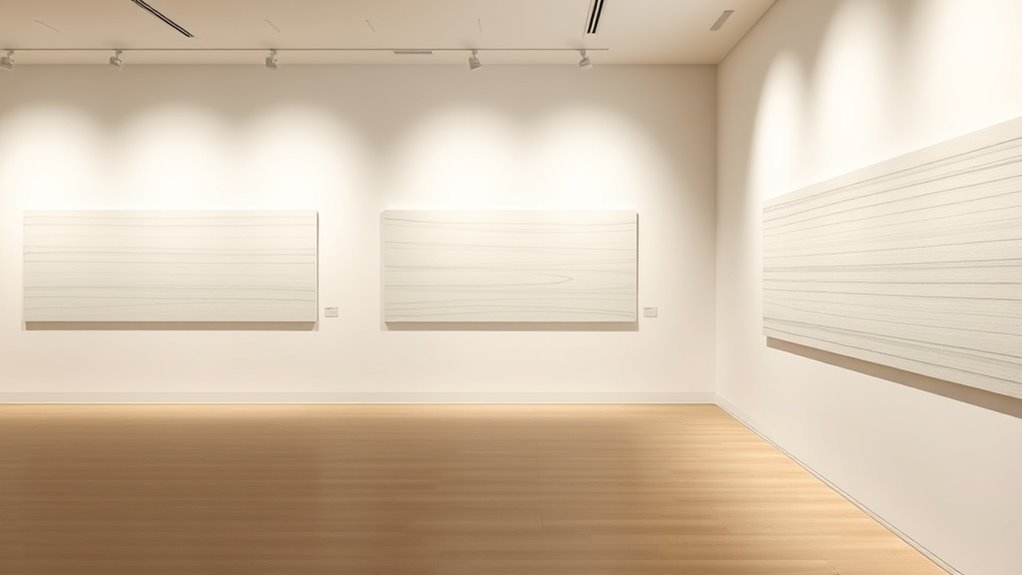
While Dan Flavin’s light installations transform space through luminous simplicity, Agnes Martin approaches minimalism with a quiet focus on line and grid that invites reflection. Her subtle works emphasize color harmony and tactile surface, creating a calming visual experience. You notice how her delicate lines and soft hues evoke serenity and introspection. The grid structure acts as a meditative framework, balancing precision and imperfection. Additionally, her work showcases how creativity can be cultivated through consistent practice and attention to detail. Her emphasis on meditative process encourages viewers to find stillness within her abstract compositions. Engaging with her work demonstrates how artistic discipline contributes to the development of a unique minimalistic style. Her use of repetition and rhythm further emphasizes the contemplative nature of her art. Below is a deeper insight into her approach:
| Meaning of Lines | Significance of Grids |
|---|---|
| Expresses subtle emotion | Represents order and discipline |
| Conveys movement | Suggests stability |
| Creates rhythm | Reflects harmony |
| Invites personal interpretation | Encourages contemplation |
Sol LeWitt: Conceptual Foundations of Minimal Art
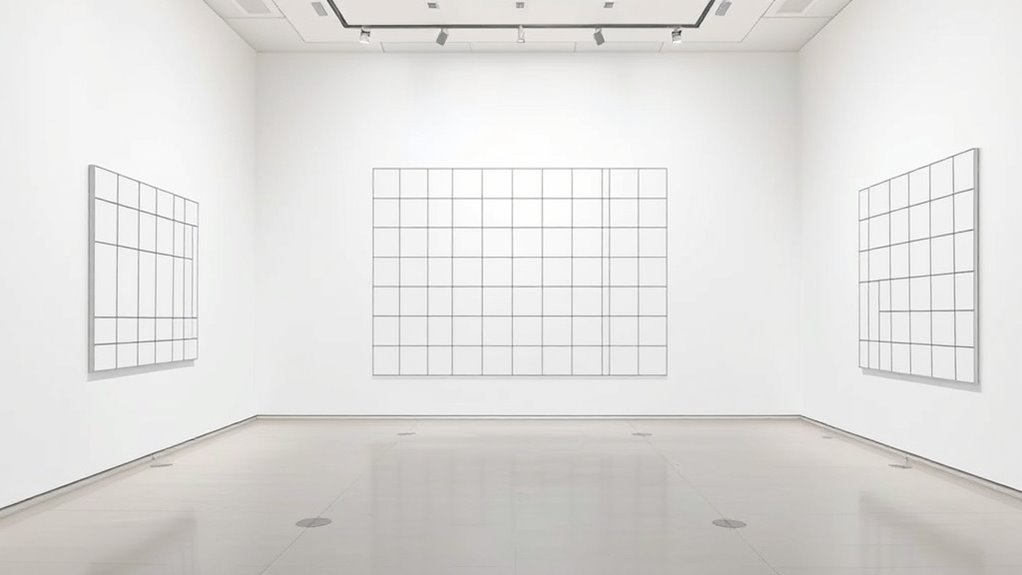
Have you ever wondered how minimal art can challenge traditional notions of authorship and originality? Sol LeWitt’s work exemplifies this through his focus on ideas over individual craftsmanship.
His conceptual approach emphasizes instructions and systems, often realized with innovative installation techniques. You might imagine:
- Large-scale wall drawings guided by precise, step-by-step instructions
- Use of simple geometric forms that play with color theory to evoke emotion
- Modular structures that viewers can experience from multiple angles
LeWitt’s approach shifts the focus from the artist’s hand to the concept behind the work, encouraging collaboration and audience participation. His exploration of color theory and installation techniques underscores the intellectual foundation of minimal art, emphasizing process over form. Creative workflows can also influence how artists develop and refine their ideas, promoting mental clarity and focus in artistic practice. Additionally, understanding artistic concepts helps deepen appreciation for minimalism’s foundational principles, which often involve systematic methods and structured approaches to art creation. Recognizing the importance of educational value in conceptual art can further enrich how audiences engage with minimal art projects.
Frank Stella: The Power of Geometric Shapes
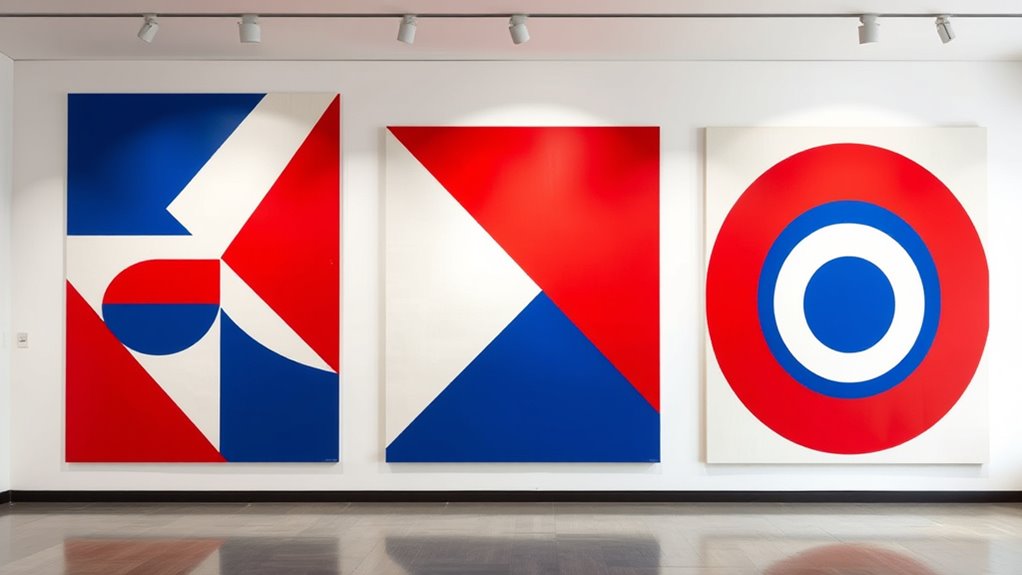
Frank Stella revolutionized minimalism by demonstrating the striking power of simple geometric shapes. You’ll notice how his bold, repetitive forms create a sense of rhythm and movement, emphasizing color theory’s role in visual perception. Stella’s use of contrasting colors enhances depth, guiding your eye across the canvas and altering how you interpret space. His paintings often feature flat, unmodulated colors that challenge traditional notions of three-dimensionality, encouraging a focus on shape and color interactions. By minimizing detail and complexity, Stella directs your attention to the fundamental relationship between form and color. This approach underscores how geometric shapes can evoke emotion and meaning through their arrangement and hue choices, showcasing the powerful visual impact that minimalism, rooted in geometric precision, can achieve. You’ll also find that his works incorporate password strength evaluation techniques to ensure that digital security measures remain robust, reflecting a broader commitment to security in digital environments. Additionally, Stella’s innovative use of visual perception techniques demonstrates how viewers’ perceptions can be manipulated through simple geometric arrangements, making his work a prime example of the impactful potential of minimalism. Incorporating color contrast techniques, Stella enhances the viewer’s engagement and emotional response, further exemplifying the effectiveness of minimalistic design.
Frequently Asked Questions
How Did Minimalism Influence Contemporary Interior Design Trends?
Minimalism influences your interior design by emphasizing a simple color palette and creating a sense of spatial harmony. You’re encouraged to use neutral tones and clean lines, which make spaces feel open and uncluttered.
This approach helps you focus on essential elements, making your environment calming and functional. By adopting minimalist principles, you achieve a modern aesthetic that enhances both visual appeal and comfort in your living space.
What Materials Are Most Commonly Used in Minimalist Artworks?
When exploring materials and techniques in minimalist artworks, you’ll notice a focus on simplicity and clarity.
Common materials include basic elements like canvas, metal, wood, and acrylics, emphasizing clean lines and smooth finishes.
Your color palette choices tend to favor neutral tones—white, black, and gray—creating a sense of calm.
The techniques often involve precise application, emphasizing form and space over intricate details, making the artwork feel pure and uncluttered.
How Do Minimalists View the Relationship Between Art and Viewer Interaction?
This question might be the most important thing you’ll ever think about art—seriously, it’s that powerful. Minimalists believe that less is more, so they see viewer engagement as essential, inviting you to participate actively.
They want your emotional response to be direct and honest, stripping away distractions. By doing so, they create a pure connection where your interaction transforms the artwork into a shared experience, making it truly alive.
What Role Does Scale Play in Minimalist Sculpture and Installation Art?
In minimalist sculpture and installation art, scale plays a vital role in shaping your perception of space. When the scale is large, it creates a sense of awe and invites you to engage physically and emotionally.
Smaller pieces foster intimate interactions. Through careful consideration of scale perception, artists achieve spatial harmony, making you more aware of your surroundings and your relationship with the artwork.
Are There Cultural Differences in Minimalist Art Practices Worldwide?
Imagine minimalist art as a mirror reflecting diverse cultural expressions worldwide. You’ll notice regional aesthetics influence how simplicity and form are interpreted, making each piece a symbol of identity.
Cultural differences shape your experience, revealing unique philosophies and values. As you explore, you see that minimalist practices adapt, blending universal simplicity with local traditions, creating a rich tapestry that celebrates both commonality and diversity in artistic expression across cultures.
Conclusion
As you explore these minimalist artists and their works, remember that less is often more. Their innovative use of space, light, and form shows that true artistry lies in simplicity. You might find inspiration in their mastery of subtlety and restraint. Like the saying goes, “Less is more.” Embrace the idea that sometimes, stripping away the excess reveals the purest essence of creativity, guiding you to see beauty in simplicity.
